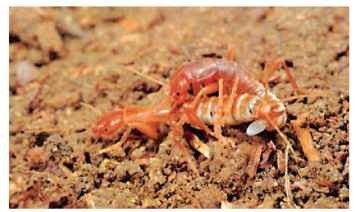The Grylloblattodea, or ice crawlers, are a small group of soft-bodied, apterous, terrestrial, and termitelike insects confined to the Northern Hemisphere. They occur under rocks in forest leaf litter or above the treeline in the high mountains. In parts of the United States, Canada, and China they are found under rocks in the soil at or below freezing temperature. In Japan and Korea, they are active in midsummer in the deep leaf litter of mixed conifer and deciduous forests, where daily ambient temperatures approach 30°C. In Japan and Korea, some have been found in caves; in the western United States, they are known from subterranean lava tubes. Grylloblattids are slender, depressed insects covered with fine hairs and having reduced eyes. Adults range from 2 to 3.5 cm in length. Ice crawlers appear to be primarily nocturnal. They are considered to be some of the most primitive of orthopteroid insects and have been thought to be related to cockroaches (Blattodea) and stick insects (Phasmida). However, recent molecular phylogenetic and morphological studies of the attachment structures in insects support a sister group relationship with the Mantophasmatodea. Some authors even place both groups as superfamilies in a single order, the Grylloblattodea (or Neoptera).
CLASSIFICATION AND FEATURES OF THE ORDER
The Grylloblattodea (Grylloblattida of some authors) comprise a single extant family, Grylloblattidae, which includes only five genera. Grylloblatta occurs in western North America and Canada, where at least 11 species are known. Grylloblattina is known from one species from Russian Far East. Grylloblattella has two known species from Siberia. Galloisiana contains at least 12 species from Japan and east continental Asia. Nambungia has two known species, including the largest-known grylloblattid. The group, however, is undoubtedly larger, since new species are discovered every few years. Kim and Lee (2007) provided an excellent review of the group and its 27 known species in their revision of Galloisiana Gurney. The Tree of Life web project has provided a phylogeny of the known living genera following the molecular analysis of Jarvis and Whiting (2006). There is considerable interest and controversy in the fossil species of the group because these insects contain the sister groups of the modern Plecoptera (see Bethoux et al., 2005). Other work using molecular analysis by Terry and Whiting (2005) has shown that the Grylloblattodea is a sister group of the recently discovered order Mantophasmatodea.
Grylloblattids are cryptic, ground-dwelling insects that prefer wet habitats and cool temperatures. They shun light and occur under stones or in dense leaf litter. Species of Grylloblatta that live under rocks under or near snowbanks emerge after dark and feed as scavengers or predators on dead or dying insects that have been blown onto the snow from lower elevations. During winter, the species probably occupy the airspace between the ground and overlying snowpack, where they remain active at temperatures of 0°C. Massive fat bodies build up prior to winter; during winter, the insects may feed on decaying plant material. Korean species live under debris on the floor of caves at only 200 m altitude and apparently never venture forth from their cave habitat. The most-widespread species in Japan, Galloisiana nipponensis, is found at elevations ranging from 300 to 3000 m, where the insects live under stones and in the leaf litter of thick, mixed coniferous and hardwood forests. These species consume both insects and plant material day and night.
The resemblance of grylloblattids to Dermaptera has been shown to be superficial and is limited to the fact that both have a projecting head. The head, however, is typical of orthopteroid insects. The antennae are elongated and thin. The mouthparts are structured like those of a predator. Ocelli are absent, and the eye comprises fewer ommatidia in young instars than in adults. The legs are simple, slender, and not suited for jumping. The abdomen has 11 segments, with long and flexible cerci and asymmetrical male genitalia. The ovipositor has three pairs of slender, tapering, partly free valves.
Although grylloblattids are normally considered to be cold-adapted insects, they cannot withstand temperatures much below 0°C. At —5.5 to 8.0°C, they become stressed. Contrary to the popular belief that they can withstand very low temperatures, they can be killed by ice formation within the body as a result of their low levels of glycerol, sorbitol, or erythrol.
Copulation has been observed in a few species. In G. nipponensis (Fig. 1), the female is chased and seized by the male. The resulting

FIGURE 1 Copulating pair of grylloblattids, G. nipponensis: the female is the lower individual (note ovipositor); the male has the eversible sac of the left phallomere exposed.
copulation can last from 30 min to 4h. Males always assume a position on the right side of the female as a response to the male’s asymmetrical genitalia. Oviposition occurs 10-50 days after copulation. Females lay eggs with the elongate ovipositor in wood or under stones and decaying plant material. No eggs have been found in moss. Oviposition for each egg takes about 3 min, and females lay five or six eggs per day to a total of about 30 eggs. A captive female can lay 145 eggs in her lifetime. The large, black eggs, develop over periods ranging from 5 months to 3 years.
